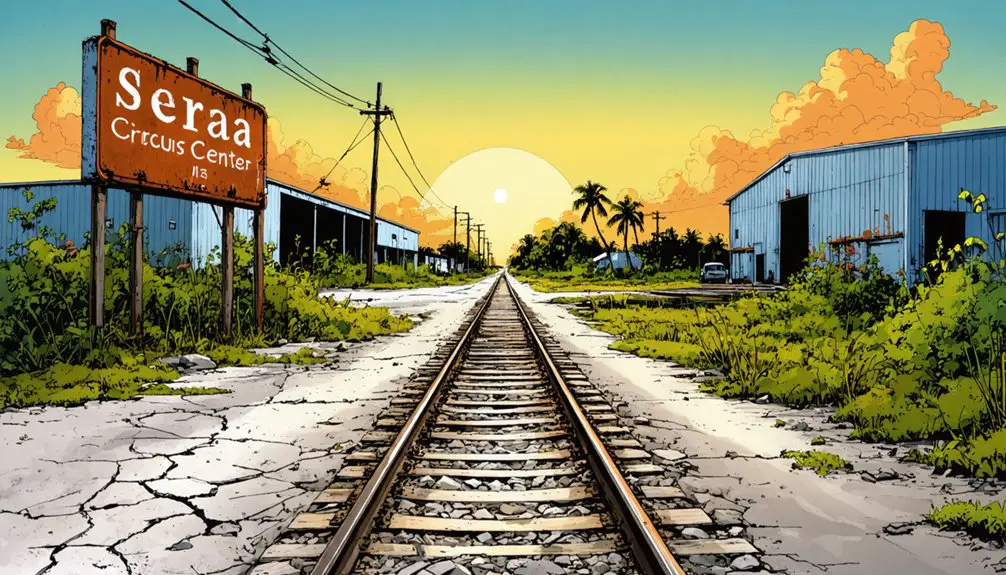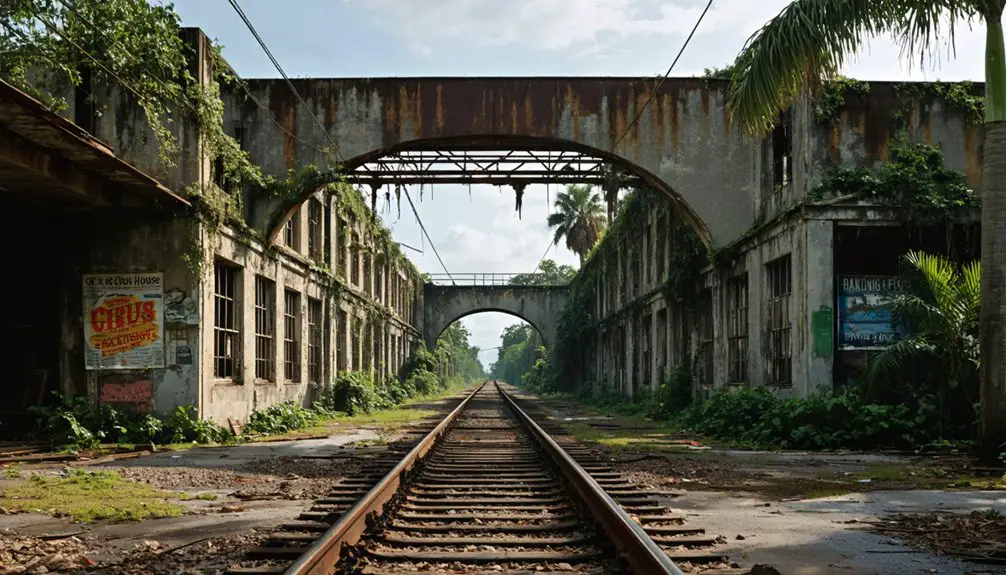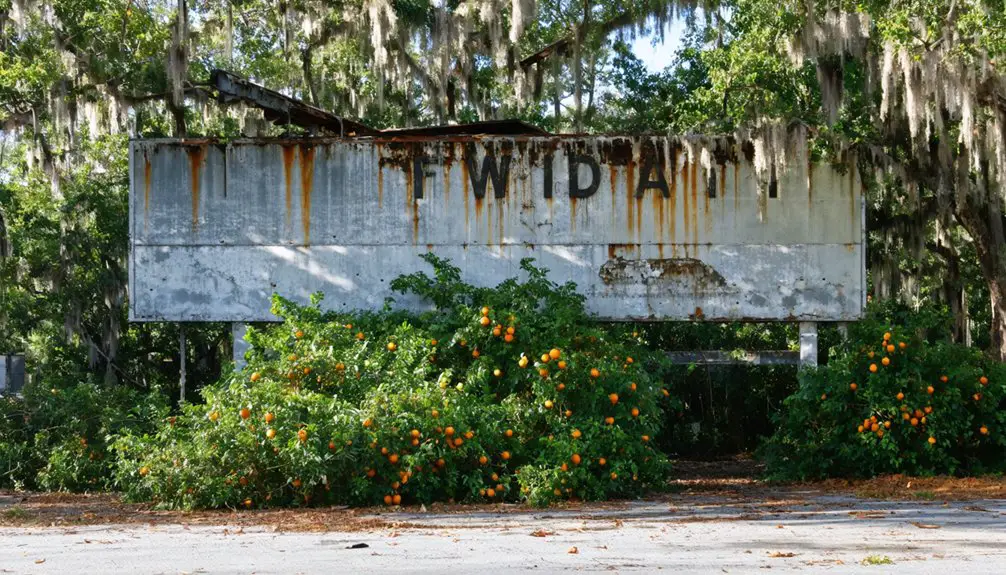You’ll find Citrus Center’s remains in Florida’s agricultural heartland, where it once thrived as a bustling citrus industry hub in the early 1900s. The town boasted nearly 100 residents, a commercial district, and served as an essential riverboat stop on the Caloosahatchee River. Devastating freezes, citrus diseases, and economic challenges transformed this prosperous community into a ghost town, with only a solitary road sign remaining. Its story captures Florida’s complex agricultural evolution.
Key Takeaways
- Citrus Center was a thriving agricultural community with 100 residents, centered around citrus production and river transport on the Caloosahatchee.
- The devastating freeze of 1894-1895 killed 99% of local citrus trees, triggering the town’s initial decline.
- Only a solitary road sign remains of the original town, with most historic buildings and landmarks lost to time.
- The town’s abandonment accelerated due to citrus diseases, hurricanes, and changing transportation routes that bypassed the settlement.
- Once-bustling packing houses and processing facilities now stand abandoned, symbolizing the ghost town’s transformation from agricultural prosperity.
Origins and Early Settlement in Florida’s Citrus Belt
While Spanish colonists first introduced oranges to Florida from Valencia in the late 15th century, the region’s citrus industry wouldn’t begin to take shape until centuries later.
You’ll find that citrus cultivation spread gradually along Florida’s east coast, with travelers noting oranges growing in St. Augustine as early as 1579. Douglass Dummitt’s technique revolutionized orange cultivation in the 1820s.
The area’s agricultural development continued to expand, with pioneers like the Yamato Colony establishing major citrus operations in the early 1900s.
The Rise of a Citrus Industry Hub
Although citrus cultivation had existed in Florida since colonial times, the mid-1870s marked a transformative period as the industry exploded into a full-scale commercial enterprise.
Florida’s citrus industry leaped from small colonial farms to booming commercial operations during the pivotal decade of the 1870s.
You’ll find that “orange fever” swept through entrepreneurs who were drawn by reports of substantial profits and growing market demand. Baer and Campbell Co. established one of the most successful operations by shipping nationwide from their packinghouses.
The industry’s expansion brought critical agricultural innovations to the region. By the 1910s, significant advancements in sprayer technology helped protect and maintain healthy citrus groves. As you explore this era, you’ll discover how growers strategically moved south to escape devastating freezes, while research centers developed resilient citrus varieties.
Leesburg emerged as an early commercial hub, where you could witness the bustling activity of packing houses and shipping operations. The introduction of refrigerated railcars opened up northern markets, though success wasn’t guaranteed – new groves required years of careful cultivation before bearing profitable fruit.
Town Infrastructure and Peak Years
At its height, you’d find Citrus Center bustling with nearly 100 residents around a commercial district anchored by an impressive two-story hotel built in 1917.
The town later suffered setbacks similar to those that affected the wider Florida citrus industry, when devastating freezes forced many growers to relocate their operations further south.
You could witness the town’s strategic position as a major boat stop on the Caloosahatchee River, which facilitated both passenger transport and the shipping of agricultural goods like watermelons, tropical fruits, and honey.
The town featured a dedicated post office and church serving the local population.
Your visit during these peak years would have revealed a well-connected community that thrived on its position along both river and road networks, though this prosperity would later decline when new road construction bypassed the settlement.
Commercial District Layout
The commercial district of Citrus Center featured a strategic layout centered around downtown Inverness, the Citrus County seat, with prominent office buildings and the county courthouse serving as focal points.
The urban planning emphasized accessibility, positioning the district near major thoroughfares like East Gulf to Lake Highway to facilitate regional commerce and travel. Following design principles similar to those used in the construction of Orlando’s first modern skyscraper, the district prioritized efficient use of vertical space. During its peak, the area drew 500,000 annual visitors who came to experience the region’s attractions and amenities.
You’ll find the commercial architecture reflected a sophisticated mix of uses, with buildings designed to serve both permanent residents and seasonal visitors.
The district’s layout maximized efficiency by clustering commercial, administrative, and service functions in close proximity.
Mixed-use structures dominated the landscape, incorporating retail storefronts at street level while housing offices and government services in upper floors, creating a vibrant, walkable downtown core that supported the local economy.
Transportation Hub Significance
Beyond the commercial district’s carefully planned layout, Citrus Center’s prominence as a transportation hub shaped its development and peak-year success. The transportation evolution centered on the Tampa & Gulfcoast Railroad, which connected the town to major sawmills and the Tampa Bay region. The railroad helped link Citrus Park to key operations like Lyon Pine Mill and other essential sawmills. Today’s plans for a new intermodal center aim to revitalize the area’s transportation heritage.
You’ll find that rail significance dominated the town’s infrastructure, with commercial zones strategically positioned around rail lines and depots.
- Rail networks enabled efficient transport of citrus and lumber to broader markets
- Dirt roads complemented rail access, linking farms to commercial areas
- Infrastructure supported boarding houses for transient workers and merchants
- Transportation hub attracted retail and service businesses
- Rail-based freight movement peaked in the early-mid 20th century, sustaining economic importance
Peak Population Growth
During its peak years in the early 20th century, Citrus Center sustained a population exceeding 100 residents while supporting robust commercial and agricultural infrastructure.
You’ll find evidence of early growth in the region’s census data, which showed Citrus County reaching 6,731 residents by 1910, with Citrus Center following similar upward trends.
The town’s community resilience manifested through its diverse economic activities, from citrus farming to moonshine production in the post-World War I era.
Environmental Challenges and Agricultural Setbacks

While citrus farming once thrived in Florida’s Citrus Center, devastating environmental challenges and agricultural setbacks have transformed this once-prosperous region into a ghost town.
You’ll find that citrus greening disease, coupled with urban encroachment, dealt the heaviest blows to local agriculture, forcing many farmers to abandon their groves or sell to developers.
- Disease-ravaged trees produced bitter, unmarketable fruit, causing annual losses exceeding $1 billion.
- Citrus production plummeted from 150 million boxes in 2004 to just 16 million by 2023.
- Intensifying hurricanes and extreme weather events damaged groves and prolonged recovery periods.
- Rising production costs and labor shortages pushed many growers out of business.
- Development pressure accelerated the conversion of agricultural land to residential and commercial use.
The Great Freezes: A Town’s Breaking Point
When you study Florida’s citrus towns in the 1890s, you’ll find that the winter of 1894-1895 brought unprecedented devastation as temperatures plummeted to 18°F in Orlando and even lower in surrounding regions.
You’ll discover that the December 1894 freeze initially damaged fruit crops, but the second freeze in February 1895 delivered a fatal blow by killing mature trees and destroying new growth that had emerged during the intervening warm spell.
As land values plummeted from $1,000 to $10 per acre, you’ll see how countless small farmers abandoned their groves and communities, transforming once-thriving settlements like Citrus Center into ghost towns.
Devastating Winter of 1894
The devastating winter of 1894-1895 brought two catastrophic freezes that forever changed Florida’s citrus industry and the fate of Citrus Center.
You’d have witnessed temperatures plummeting to unprecedented lows, first in December 1894 and again in February 1895, devastating the region’s citrus cultivation and economic stability.
- Temperatures dropped an astounding 62°F in less than 24 hours during February’s freeze
- Ice formed inside tree trunks, causing them to split and destroying decades-old orchards
- 99% of Lake County’s citrus trees perished in the disaster
- Small growers couldn’t survive the lengthy recovery period needed for new trees
- Citrus cultivation shifted southward to less frost-prone regions
These brutal freezes forced many farmers to abandon their land, permanently altering Citrus Center’s future and reshaping Florida’s agricultural landscape.
Life After Fatal Frost
Following those devastating freezes, Citrus Center experienced a rapid and irreversible decline that would ultimately lead to its abandonment.
You’ll find that despite various frost adaptation strategies, including the cultivation of hardier citrus varieties and improved site selection, the town couldn’t recover its agricultural prominence. Community resilience efforts proved insufficient as the economic foundation crumbled.
The collapse triggered a devastating chain reaction: businesses shuttered, land values plummeted, and residents fled south or to urban areas.
You can trace the town’s demise through its deteriorating infrastructure – abandoned packinghouses, decommissioned rail lines, and empty homes.
The few who remained faced dwindling services and a fractured social fabric. This single-industry town’s vulnerability to environmental disaster serves as a stark reminder of the risks of economic dependency.
Transportation Networks and Economic Shifts

Located strategically along the Caloosahatchee River, Citrus Center initially thrived as an essential transportation hub where riverboat traffic facilitated robust trade in watermelons, tropical fruits, and honey.
The transportation evolution you’ll find fascinating shows how the town’s fortunes changed dramatically when new road networks bypassed the community, leading to economic decline.
- Riverboat transport was crucial before road infrastructure improvements
- Roads initially connected Citrus Center to Moore Haven and Ortona
- Railroad development in Central Florida shaped settlement patterns
- The 1926 hurricane weakened transport-linked economic activity
- Loss of direct transport routes reduced business incentives
You’ll see how the shift from river to road transportation, combined with agricultural challenges and environmental disasters, transformed this once-bustling hub into a ghost town.
The closure of roads to public access ultimately sealed the community’s fate.
Physical Remnants and Historical Markers
Despite Citrus Center‘s once-thriving status as a transportation hub, physical remnants of this ghost town have largely vanished from Florida’s landscape, with only a solitary road sign on Highway 78 marking its former location.
You’ll find no trace of the two-story hotel, church, school, or homes that once defined this community. While Polk County erected several citrus-themed monuments around 1930 to attract tourism, including one misspelled as “Citurs Center,” these historical markers now stand weathered and graffiti-marked.
The original access road remains closed to the public, limiting exploration of any remaining remnant structures. Unlike nearby ghost towns such as Orleans, which maintain visible cemetery plots, Citrus Center’s physical legacy exists primarily through its roadside monument and historical records.
County Rivalries and Political Dynamics

While Citrus Center’s demise marked the end of one era, the broader region’s political dynamics were shaped by deep-seated rivalries between Citrus and Hernando counties.
These county tensions emerged from Citrus County’s 1887 split from Hernando, leading to decades of political struggles over resources, development, and regional influence.
- Control over railroad routes and infrastructure sparked fierce competition between county governments.
- Citrus County’s phosphate mining interests clashed with Hernando’s agricultural priorities.
- Political representation battles intensified as demographic shifts altered both counties.
- Boundary disputes near Lecanto fueled ongoing territorial disagreements.
- Each county’s distinct approach to governance created competing visions for development and conservation.
You’ll find these rivalries reflected in everything from tax policies to the strategic placement of government facilities, showing how local politics shaped the region’s evolution.
From Citrus Groves to Ghost Town Status
You’ll find that Citrus Center’s transformation into a ghost town began with devastating freezes, particularly the harsh winter of 1894-95 that destroyed many of the town’s citrus groves.
The economic fallout from these environmental disasters, combined with new highways bypassing the settlement, led many residents to abandon their homes and businesses in search of better opportunities elsewhere.
The once-bustling town, with its prominent two-story hotel and thriving agricultural trade, now stands empty with only closed roads and historical markers to remind visitors of its former vibrancy.
Harsh Winters Kill Groves
Throughout Florida’s citrus history, the devastating impact of harsh winters irreversibly transformed once-thriving agricultural communities like Citrus Center into ghost towns. The failure of citrus resilience against severe freezes, particularly the Great Freeze of 1894-1895, dealt a crushing blow to the town’s economic foundation.
Despite attempts at climate adaptation, repeated winter freezes in the 1980s ultimately ended commercial citrus production in the region.
- The Great Freeze wiped out entire groves, causing widespread economic decline
- Recovery costs for replanting proved insurmountable for many farmers
- Population declined as settlers abandoned their unproductive groves
- Essential infrastructure deteriorated as tax revenues plummeted
- The 1926 hurricane compounded freeze damage, accelerating the town’s demise
When you consider the relentless pattern of harsh winters, you’ll understand why Citrus Center couldn’t sustain its agricultural heritage.
Economic Hardships Force Exodus
The harsh winters that devastated Citrus Center’s groves marked just the beginning of a broader economic collapse that would transform this once-vibrant agricultural hub into a ghost town.
You’ll find that the community’s economic decline accelerated dramatically after 2005 when citrus greening disease ravaged the remaining groves. As production plummeted by over 90% across Florida, Citrus Center’s growers faced mounting losses from soaring costs and rock-bottom fruit prices.
The community migration began as farmers abandoned their operations, unable to sustain profitability. Hurricanes Irma and Ian delivered the final blows, destroying crops and discouraging reinvestment.
Without the citrus industry’s economic foundation, local employment vanished. The exodus intensified as support businesses closed, leaving behind empty storefronts and abandoned groves as silent testimonies to a once-thriving agricultural empire.
Empty Buildings Tell Story
Standing as silent sentinels to Citrus Center’s agricultural legacy, abandoned packing houses and processing facilities now tell a haunting story of decline through their deteriorating facades and overgrown grounds.
These structures, once vibrant centers of Florida’s citrus empire, showcase both cultural significance and architectural heritage despite their decay. You’ll find historic landmarks like the Strawn Packing House District speaking volumes about pioneer innovation and industrial prowess.
- Severe vandalism and looting plague buildings despite security measures
- Fire damage from 2008 and 2010 accelerated structural deterioration
- The Marion S. Whaley facility, demolished in 2020, marked the end of an era
- Florida limestone construction shows resilience against time’s ravages
- Safety hazards and code violations force difficult preservation choices
These empty sentinels stand as powerful reminders of your region’s agricultural roots and economic transformation.
Legacy in Florida’s Agricultural History
Once a thriving agricultural hub in Glades County, Citrus Center exemplifies Florida’s complex relationship with citrus farming and agricultural development.
You’ll find in its story a reflection of the state’s broader agricultural evolution, from the ambitious plantings of the early 1900s to the devastating freezes that reshaped the industry. The town’s citrus heritage lives on through physical remnants like the two-story hotel and old brick roads that once supported a bustling economy.
More than just a ghost town, Citrus Center represents the resilience of Florida’s farming communities.
When citrus crops failed, farmers adapted by diversifying into watermelons, tropical fruits, and honey production. Their story demonstrates how agricultural communities responded to environmental challenges while maintaining their cultural identity through landmarks, place names, and community structures.
Frequently Asked Questions
What Was the Exact Population of Citrus Center During Its Peak Years?
You can’t pinpoint the exact population dynamics during peak years, though historical significance suggests at least 100 residents around 1917, when the town boasted a hotel, school, and church.
Were There Any Notable Crimes or Scandals in Citrus Center’s History?
You won’t find documented crime history or major scandal details from Citrus Center’s past, though there’s evidence of moonshine production during Prohibition – a common underground activity in 1920s Florida.
What Happened to the Residents After They Abandoned Citrus Center?
After the 1926 hurricane, over 80% of residents relocated to nearby towns like Moore Haven. You’ll find their post-abandonment life centered around dredging work, turpentine harvesting, and farming in Glades County communities.
Did Any Famous People Ever Live in or Visit Citrus Center?
You won’t find any records of famous visitors or celebrity sightings in this small pioneer town. Historical documents and local accounts don’t mention any notable figures ever living there or passing through.
What Was the Average Land Price for Citrus Groves in Citrus Center?
While you’d expect precise records for such valuable land, there aren’t specific average citrus prices documented for this location, though nearby groves saw dramatic fluctuations between $6,000-$14,000 per acre.
References
- https://cccourthouse.org/wp-content/uploads/2023/12/Ghost-towns-and-Cemeteries-of-Citrus-County.pdf
- https://floridatrailblazer.com/2018/04/10/orleans-ghost-town-in-citrus-county/
- http://www.desolationflorida.com/2016/08/citra.html
- https://jewishcurrents.org/ghosts-of-the-groves
- https://www.tripadvisor.com/Attraction_Review-g34402-d1643716-Reviews-Forgotten_Citrus_Center_Monument_2-Loughman_Florida.html
- https://pbchistory.org/a-story-of-agriculture/
- https://blogs.ifas.ufl.edu/ifascomm/2014/09/12/like-a-day-without-sunshine-the-past-and-future-of-florida-citrus/
- https://dos.fl.gov/historical/museums/historical-museums/united-connections/foodways/food-cultivation-and-economies/the-citrus-industry-in-florida/
- https://fcit.usf.edu/florida/docs/f/fruit.htm
- https://delandhistoricalsociety.com/blog/start-of-the-citrus-industry-in-florida



